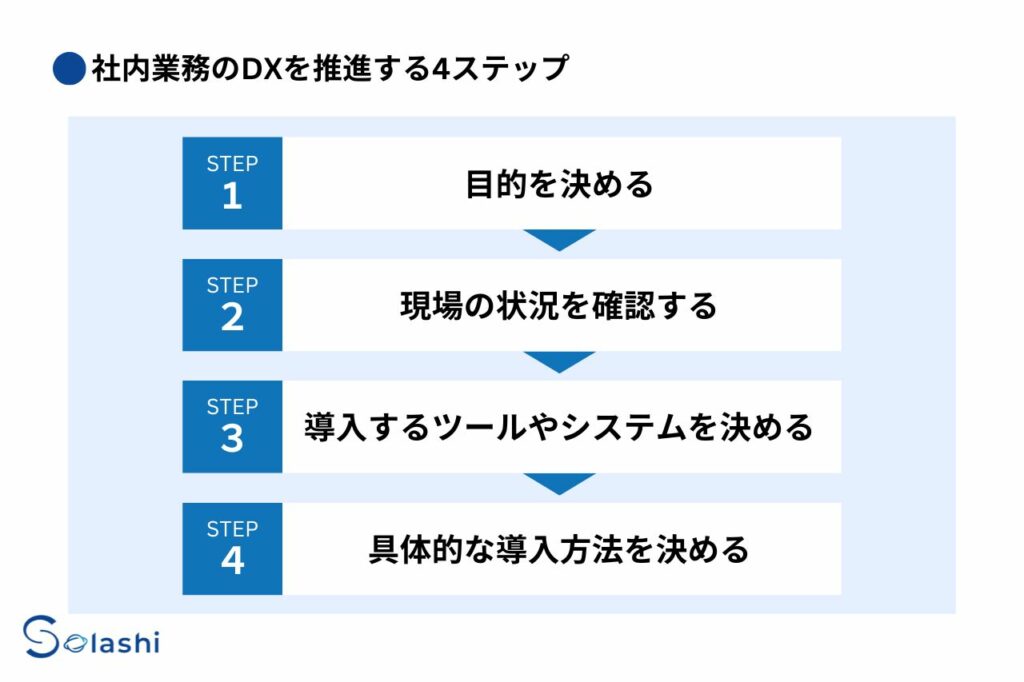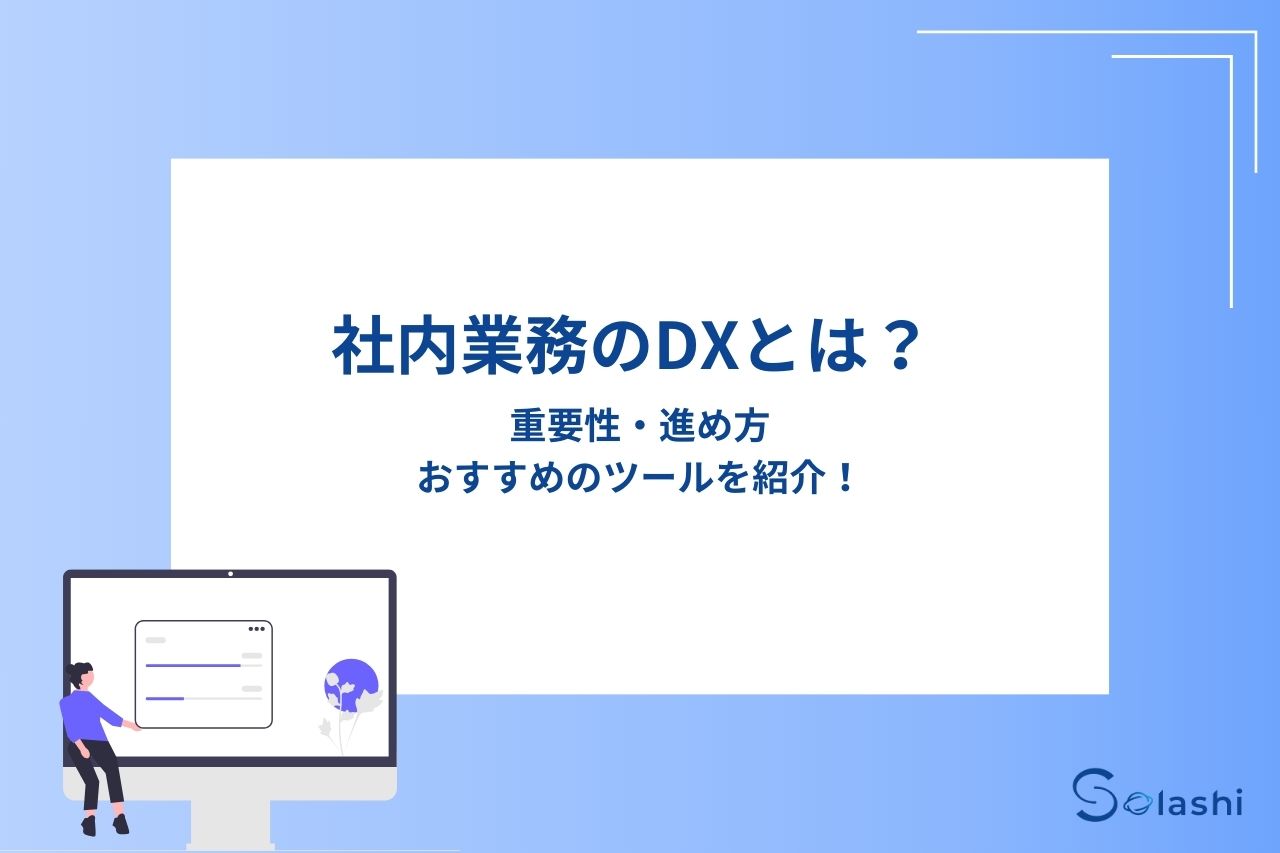Amid the recent wave of rapid digitalization, DX has been positioned as a crucial management strategy that determines a company’s competitiveness. However, even though many understand the importance of internal DX, there are still numerous employees who find actual implementation quite challenging.
“We want to promote DX, but don’t know where to start.”
“We can’t see any concrete methods suitable for our company.”
“Do we even need DX in our business operations?”
This article addresses these questions by explaining why DX for internal operations is necessary and how to proceed. It also introduces key points for successful DX implementation and recommends useful tools, so please use it as a reference.

Akira Shimazoe
CEO of Solashi Japan LLC. Engaged in the development and operation of internal systems at Suntory. Founded Yper Inc., serving as CTO and CPO, contributing to product launch and growth.
What is DX?
DX (Digital Transformation) refers to efforts to drive transformation within companies through digital technology and enhance competitiveness in the market. Unlike simple IT adoption or business systemization, DX involves a fundamental review of business models, organizational culture, and work processes.
Using cutting-edge technologies such as IoT, AI, big data, and cloud computing, DX aims to respond swiftly and accurately to the needs of customers and society. Promoting DX can lead not only to direct results like improved operational efficiency and cost reduction, but also to innovation, value creation, and ultimately, sustainable corporate growth.
Amid increasing environmental changes, DX is considered one of the most important management strategies companies should undertake.
What is Internal DX?
Internal DX refers to the use of digital technology to improve work processes and achieve greater productivity and efficiency. Company-wide DX consists of two components: process innovation (transforming workflows) and product innovation (creating new products and services). Internal DX falls under process innovation.
Examples include promoting paperless operations, setting up remote work environments, and automating tasks using RPA and AI. These efforts help streamline workflows, increase speed, reduce costs, and prevent human errors.
Smoother communication and information sharing within the company is also a vital role of internal DX. By utilizing business chat tools, online meeting systems, and knowledge-sharing platforms, companies can enable flexible workstyles regardless of time or location.
Through the use of such digital tools, businesses can optimize work processes, improve efficiency and productivity, and transform how work is done.
Why Internal DX is Important
Next, let’s explore the reasons why internal DX is so important.
- To address labor shortages
- To reduce costs
- To support workstyle reforms
- To comply with the invoice system
- To strengthen competitiveness
We’ll explain each of these in detail.
To Address Labor Shortages
Labor shortages are a critical issue for many businesses. This is particularly true for small and medium-sized enterprises, which often struggle to secure skilled workers. In a hiring market where new talent is hard to come by, it’s crucial to make the most of limited human resources.
This is where digital technologies come into play. By automating and streamlining operations, employees can focus on higher-value tasks. As a result, productivity per employee increases, boosting overall operational efficiency.
To Reduce Costs
Promoting internal DX also contributes to cost reduction. Digitalization and paperless initiatives cut printing expenses, while improved workflow efficiency helps reduce labor costs. Additionally, leveraging cloud services can optimize system implementation and operational costs.
While some initial investment is needed, long-term cost reductions can be expected through process improvements and systemization.
To Support Workstyle Reforms
DX plays a major role in supporting workstyle reforms, which are a key initiative promoted by the government. With goals such as correcting long working hours and encouraging flexible workstyles, companies are expected to create environments that support diverse ways of working. DX is a powerful tool for achieving this. By promoting automation and digitalization, DX enables flexible work regardless of time or location.
For example, implementing remote work allows for flexible working hours and locations. Centralizing data and documents using cloud services also allows employees to access necessary information from outside the office.
Such initiatives help improve work-life balance and enable more efficient work. They are also beneficial for employees managing life events like childcare or caregiving, allowing them to participate in work more flexibly. Thus, promoting internal DX is highly effective for workstyle reform.
To Comply with the Invoice System
The invoice system that began in October 2023 has increased complexity in billing and accounting processes, placing a significant burden on companies. Manual handling leads to a higher risk of errors and omissions, requiring thorough checks.
By promoting internal DX and automating billing tasks, companies can reduce administrative burdens and prevent human errors. For instance, invoicing tools can generate documents that meet the qualified invoice format. Additionally, using electronic bookkeeping systems ensures invoice data is stored in compliance with legal requirements. Automation through DX helps reduce the load of system compliance, allowing teams to focus on core business tasks.
To Strengthen Competitiveness
Internal DX doesn’t just improve efficiency or reduce costs—it also boosts overall corporate competitiveness.
Automation and streamlining enable employees to focus on high-value work. Time once spent on routine tasks can now be used for core or strategic activities, leading to greater productivity. The time saved through improved efficiency can also be redirected toward innovation. Resources can now go toward brainstorming new business ventures or developing new products.
In this way, internal DX not only optimizes operations but also enhances a company’s ability to transform and adapt, making it a strategic initiative with long-term benefits.
4 Steps to Promote Internal DX

From here, we will explain how to promote internal DX in four steps.
1. Define the Purpose
Start by clarifying the purpose of promoting internal DX. Understand what results the initiative is expected to achieve and how it can help resolve current issues or improve operations. Share this understanding with all stakeholders.
Sharing the purpose and gaining stakeholder understanding and cooperation is a vital first step in promoting DX. Defining a clear goal will ensure smoother implementation moving forward.
2. Assess the Current State
Next, assess the current state of your operations. Identify which tasks face what kind of issues, and visualize workflows and processes to determine where improvements are possible. Interviews with frontline employees are essential in identifying issues. Their firsthand insights into inefficiencies and opportunities for digital improvement are invaluable.
Using visual tools like flowcharts is also effective for mapping out processes. Diagramming your current workflows helps reveal inefficiencies and waste.
Once issues are identified, prioritize them based on impact and urgency. Clarify which problems to tackle first and what outcomes can be expected from DX initiatives.
3. Select Tools and Systems to Implement
Attempting to implement major reforms in a short period of time may cause confusion. Therefore, it’s important to consider realistic methods that take the burden on the workplace into account.
9 Recommended Tools to Promote DX in Internal Business Operations
When considering the promotion of DX in internal operations, many companies struggle with which specific tools to implement. In this section, we introduce 9 recommended tools that are useful for promoting DX within your organization.
If you find any tools that might be suitable for your company, please use them as a reference.
- Business Chat Tools
- Online Meeting Systems
- Knowledge Management Tools
- Task Management Tools
- RPA Tools
- SFA Tools
- BI Tools
- Expense Management Systems
- HR Systems
1. Business Chat Tools
Business chat tools are chat platforms designed to facilitate smooth internal communication and information sharing. Popular examples include Slack, Chatwork, and LINE WORKS. These tools enable quick communication between individuals and departments, streamlining information sharing and file exchange.
Compared to traditional email, these platforms allow for more casual interactions, making internal communication faster. Features like threads help organize conversations by topic. Additionally, past messages and files are easy to search, contributing to centralized information management. With a low barrier to entry and easy learning curve, business chat tools are ideal as a first step toward DX.
2. Online Meeting Systems
Online meeting systems, also known as web or video conferencing tools, include widely used platforms like Zoom, Google Meet, Skype, and Microsoft Teams. These tools enable users to replicate in-person meetings with offices, branches, or business partners effortlessly.
Major benefits include reduced travel time and costs, and easier scheduling. Many platforms offer advanced features such as file sharing and editing, recording, and archiving. By facilitating smooth communication online, these tools support flexible work styles that transcend geographical limitations.
3. Knowledge Management Tools
Knowledge management tools are systems designed to organize and share internal knowledge and information in a structured way. Popular tools include kintone, Kibela, and Accela BizAntenna.
These tools help accumulate valuable insights and know-how, leading to overall skill enhancement across the organization. They also improve the accessibility and searchability of information, supporting employees’ self-learning and faster problem-solving. Knowledge management tools can store diverse knowledge not typically included in manuals, making it easier to share expertise that was traditionally passed on verbally.
4. Task Management Tools
Task management tools visualize individual and team tasks to support efficient management. Popular examples include Trello, Asana, Wrike, and Jira. These tools enable seamless task assignment, deadline setting, and progress tracking.
They also feature Gantt charts for visualizing progress and reminders for upcoming deadlines, supporting smooth task execution. By being mindful of total workload and time allocation, these tools help achieve efficient, waste-free work styles.
5. RPA Tools
RPA (Robotic Process Automation) tools automate routine tasks that were previously performed manually. Well-known tools include Blue Prism, UiPath, and WinActor.
By automating tasks such as Excel operations and email handling, RPA tools enhance efficiency and prevent human errors. This allows employees to focus on higher-value work, significantly boosting productivity. RPA is cost-effective to adopt and easy to learn, making it a great starting point for business process improvement. We recommend starting small and gradually expanding the scope.
6. SFA Tools
SFA (Sales Force Automation) tools help streamline and optimize sales activities. Representative tools include Sales Cloud, Mazrica Sales, and Next SFA.
They centralize information such as negotiation history, customer data, and deal progress. By aggregating and analyzing sales-related information, these tools help optimize sales strategies and improve marketing efforts. They also facilitate information sharing and coordination among sales representatives, strengthening the sales team’s overall performance.
7. BI Tools
BI (Business Intelligence) tools are tools that enable collection, analysis, and visualization of data within a company. Representative tools include Looker Studio, Domo, and Tableau. These tools aggregate and visualize various internal data such as sales, inventory, and customer data. Through reports and dashboards, they enable intuitive understanding. By exploring data correlations and making future predictions, they help in identifying issues and formulating strategies.
More tools with advanced analytics functions using machine learning and AI are emerging. Utilizing BI tools is extremely important to harness the power of data for business management.
8. Expense Reimbursement Systems
Expense reimbursement systems are systems that streamline employee expense claims and approval processes.
Widely used tools include Rakuraku Seisan, Money Forward Cloud Expense, and Concur Expense.
Because receipts can be submitted and transportation routes applied for online, the burden and errors caused by paper documents and manual processes are significantly reduced. Especially in operations where transportation expense claims and expense settlements frequently occur, these systems can bring major benefits.
9. Human Resource Systems
Human resource systems streamline complex HR tasks such as payroll calculation, attendance management, leave requests, and year-end adjustments. By utilizing tools like freee HR, One HR, and Jinjer HR, complex HR tasks can be automated, significantly reducing mistakes and manual effort.
Additionally, centralized management of employee information helps in developing talent strategies and optimizing training based on data. From optimal talent placement to creating development plans, HR systems are vital infrastructure that support the sustainable growth of a company.
Key Points for Promoting DX in Internal Operations
Here are three key points to consider when promoting DX in internal operations.
- Share objectives and initiatives internally
- Secure DX talent
- Start small and proceed step-by-step
Share Objectives and Initiatives Internally
To promote DX, internal cooperation is essential. Frontline employees are especially affected by operational changes due to DX. Therefore, it is important to carefully explain why DX is necessary and what benefits it brings, and to share its objectives and expected effects.
For management, it is crucial to clearly communicate the strategic significance and ROI of DX. You must present a vision of how DX contributes to enhancing competitiveness and corporate value. By spreading the significance and objectives of DX throughout the organization, a smooth promotion framework can be established.
Secure DX Talent
To realize DX in internal operations, securing talent with DX knowledge and expertise is necessary. Proceeding with DX without knowledge or expertise will make it difficult to achieve desired outcomes. DX talent should not only have IT knowledge but also be well-versed in internal operations. This is because having personnel familiar with internal circumstances is essential to effectively review operations.
If your company lacks DX talent, one option is to find an external partner that offers long-term support. However, in the future, it is important to build an internal system capable of promoting DX. Alongside outsourcing, focus on developing internal IT talent.
Start Small and Proceed Step-by-Step
It is important to start small and proceed with DX step-by-step. Attempting everything at once can cause confusion due to sudden changes in the field and hinder progress. It is recommended to first implement measures for small tasks with limited impact, observe the responses and feedback from the field, and gradually expand the scope.
By applying the insights and feedback gained at each stage to the next step, you can steadily advance DX while increasing field acceptance.
Consult Solashi for Internal DX!
This article explained internal DX. Utilizing digital technologies to streamline operations brings many benefits, such as cost reduction and optimal use of human resources. To promote internal DX, a skilled development team is indispensable. However, it is often difficult to secure sufficient human resources internally.
That’s why we recommend utilizing Solashi’s lab-type development services. Highly skilled Vietnamese engineers with a wealth of experience will develop as a dedicated team. They will propose systems tailored to your needs and develop them with the best team setup. If you’re even slightly interested, please feel free to consult Solashi Co., Ltd.

Akira Shimazoe
Representative of Solashi Japan LLC. Born in April 1989 in Fukuoka Prefecture. Graduated from the Graduate School of Information and Mathematical Sciences at Osaka Prefecture University. Joined Suntory System Technology Co., Ltd., an IT subsidiary of Suntory Holdings, in 2014. Broadly responsible for the development, operation, and implementation of vending machine delivery management, efficiency improvements, and sales management systems. Founded Yper Inc. in 2017, serving as CTO and CPO. Contributed to the launch and growth of the app-linked delivery bag "OKIPPA." Selected for Toyo Keizai's prestigious "Amazing Venture 100" and Forbes' "Forbes 30 Under 30 Asia 2019."

 日本語
日本語
